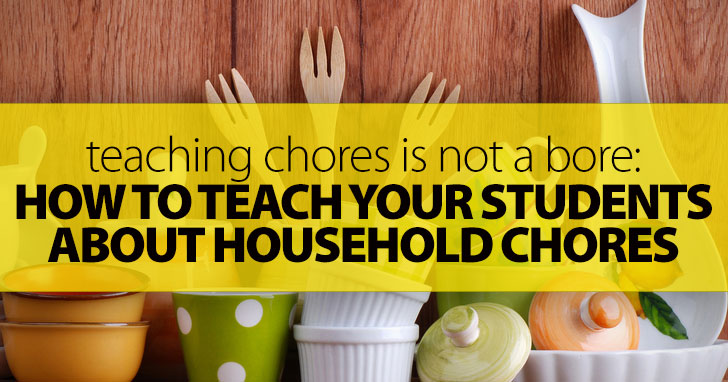Warning: 5 Activities To Teach About Household Dangers


However, household chores are an important part of our daily routines, and therefore ESL students need to learn how to communicate about them. Use the activities below to teach your students about household chores.

In order to talk about chores, your students need to have the vocabulary words. You will need to present clear pictures and labels to accompany each word. Go over all of the common household chores you feel are appropriate for your class. As you review them, ask them which one is their favorite and their least favorite. Students can say, “My favorite chore is ______________, but my least favorite chore is ____________.” Relating to them on a personal level tends to let students see how important learning these terms is to them.
Along with the names of various household chores, your students will also need to know the names of the equipment we use to do household chores, such as a broom or a vacuum. You will need to get actual examples of this equipment ahead of time to have it for your class. Show them each item, saying, “This is a ________ (item). We use it to _________ (action).” Have them repeat it back to you, paying attention to pronunciation. When you are done, place large titles of each household chore around the classroom. Choose a student, and have them come up and choose a piece of cleaning equipment. See if they can place that item under the correct label, for example they would need to put the broom under the word “sweeping.” For a fun twist on this game, divide the class into two teams. Divide the equipment up into two equal piles. The two teams will race to see who can put their equipment in the right spots first. Some friendly competition usually makes class more fun and memorable.
This involves some preparation ahead of time on your part. You will need to design a simple board game. “Blank board game templates” can easily be found online by using a search engine, and you can print one out. You will also need one pair of dice for each board. Mark some of the spaces with commands such as: “You made your bed. Go forward 3 spaces,” or “You forgot to take out the trash. Lose a turn.” Make copies of this game and laminate them. Have some item to use as markers, such as bingo chips or coins, a different one for each player. Divide the class into groups of 2-4, depending on your numbers. Have them roll the dice and move that number of spaces, reading the board as necessary. You may make it as complicated as you wish by adding spaces to the board with a “?” that lead you to pick a card. Then you would need to prepare of pile of cards with additional directions. Have fun with this activity to review the names and actions associated with household chores.
It is important that students are able to talk about their daily routines, and household chores are usually a part of that routine. This activity works best if you have already taught telling time in English. You will need to prepare a sample daily routine with times of day, such as, “7:00: Wake up. 7:15: Walk the dog. 7:30: Make breakfast,” and so on. Review this routine with your students, answering any questions. Then give them a blank template. Tell them they need to provide 5-10 (depending on the level of your class) times and routines for their typical day. Tell them to include as many household chores as possible. When everyone is done, let the students share their schedules. Compare and contrast the different schedules over a typical day.
This activity is another way to review household chores in a fun game format. You will need to prepare sets of cards ahead of time. On each card, you should write something like, “Would you rather clean the bathroom all day for a month and never have to do it again, or clean the kitchen floor with your toothbrush once a year for ten years?” These questions should be silly, but force the student to make a choice. The student should answer, “I would rather clean the bathroom all day for a month because ____________________.” Model a couple of cards for your students, so they can see what your goal is, before you divide them into groups with sets of cards. Have no more than 4 students per group, so everyone gets a chance to talk. This is a fun way to review this material.
This activity gives students a chance to use their imaginations while reviewing household chores, which is always a great way to help remember what you have learned. It may serve as a culminating activity for the topic of household chores. Begin by reviewing the various household chores and equipment that you have covered. Let your students know that today, they will have the chance to invent a robot that will do one of their chores. Provide them with a blank template that has room for: the robot’s name, its chore, how it completes its chore, how much it would cost and why they chose that specific chore for the robot. It should also have space for a drawing of the robot. This activity works for children and adults alike, as everyone would like to find a way to get out of their chores! Have them share their robots when they are done. If this is a class of children and this can be a multi-session activity, you may even want them to build the robot out of recycled materials and then present it to the class.
You can make it a bit more interesting for you and your students by using the above activities. Integrate some or all of them into your lessons soon!